Silloth to Carlisle – 36 miles, luckily very flat, miles
Health not great after yesterday’s strike of the rhinovirus, but set out with the avowed intention of going very slowly, which I accomplished. And of walking up the slopes. Ditto.
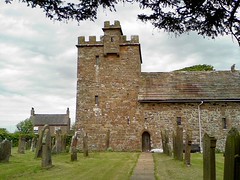 The first historical highlight of the day was the neat and attractive St John’s Church Newton Arlosh (“New Town on the Marsh”), an old pele-tower (pronounced peel, I learnt from the friendly vicar) church built as a fortress and watchtower in the 14th century, with enormously thick walls (31 inches at the door, so the guide says). The internal staircase is narrow and steep, so even if the door was forced, the upper floors could still be defended.
The first historical highlight of the day was the neat and attractive St John’s Church Newton Arlosh (“New Town on the Marsh”), an old pele-tower (pronounced peel, I learnt from the friendly vicar) church built as a fortress and watchtower in the 14th century, with enormously thick walls (31 inches at the door, so the guide says). The internal staircase is narrow and steep, so even if the door was forced, the upper floors could still be defended.
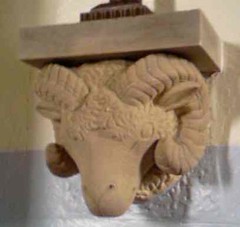 It was a monastery church, and fell into ruin after the Reformation, but it seems an amateur sculptor from the local gentry, Miss Sara Losh, who ran a school of carving at nearby Wreay, was responsible for its restoration. The rams are probably hers.
It was a monastery church, and fell into ruin after the Reformation, but it seems an amateur sculptor from the local gentry, Miss Sara Losh, who ran a school of carving at nearby Wreay, was responsible for its restoration. The rams are probably hers.
 Around the Solway peninsula, you disappear into another, very quiet world. Road hazards, as left, were mostly of varying animal origins, like this very bossy bantam cockrel rounding up his harem. (The cows had also definitely left their marks.) Overshadowing it all is an enormous radio array dating back to WWII. Presumably these are still military, although there’s little sign of security. The gun emplacements around the peninsula have been converted into cowsheds and haybarns (a nice variation on the old ploughshares…)
Around the Solway peninsula, you disappear into another, very quiet world. Road hazards, as left, were mostly of varying animal origins, like this very bossy bantam cockrel rounding up his harem. (The cows had also definitely left their marks.) Overshadowing it all is an enormous radio array dating back to WWII. Presumably these are still military, although there’s little sign of security. The gun emplacements around the peninsula have been converted into cowsheds and haybarns (a nice variation on the old ploughshares…)
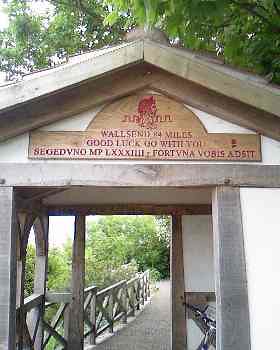 Finally then, it was, da, da, the wall, or at least its official (and actual) start on Bowness on Solway. There’s a nice little garden filled with herbs as used by the Romans (I thought about picking some burnet saxifrage, used for making “a cooling drink for throat infections”) and the official stamp box for walkers completing their trek. (They go east-west while the cycle path is west-east.)
Finally then, it was, da, da, the wall, or at least its official (and actual) start on Bowness on Solway. There’s a nice little garden filled with herbs as used by the Romans (I thought about picking some burnet saxifrage, used for making “a cooling drink for throat infections”) and the official stamp box for walkers completing their trek. (They go east-west while the cycle path is west-east.)
There is no wall to be seen, since it has been heavily robbed, as for houses like the one below – there is no local stone, so anything so built is almost certainly using Roman materials. The vallum, the curious and ill-explained ditch, built later at vast expense in human labour behind the wall, is, however, in places quite clear.
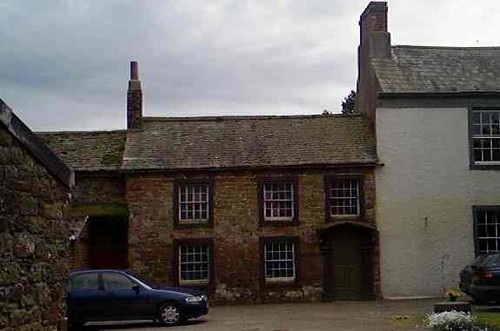
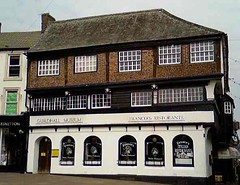 The destination of the day was Carlisle, with its grand medieval castle, and dinner was at an Italian restaurant (founded 1974, when it must have been quite an innovation for the city, and I doubt the menu has changed since). But the building is rather older, in fact an astonishing survival. Built as a merchant’s store and house late in the 14th century it has seen all subsequent military and political upheavals. Such buildings are usually restored to within an inch of their life, but the internal beams, of truly massive oak, look to be original – trees of that size just weren’t found much past that time.
The destination of the day was Carlisle, with its grand medieval castle, and dinner was at an Italian restaurant (founded 1974, when it must have been quite an innovation for the city, and I doubt the menu has changed since). But the building is rather older, in fact an astonishing survival. Built as a merchant’s store and house late in the 14th century it has seen all subsequent military and political upheavals. Such buildings are usually restored to within an inch of their life, but the internal beams, of truly massive oak, look to be original – trees of that size just weren’t found much past that time. 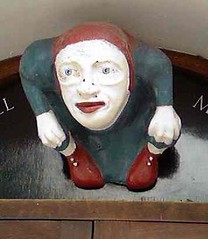 It is guarded by these attractive figures. Apprentices maybe?
It is guarded by these attractive figures. Apprentices maybe?
(The map on this suggested cycle route will help you orientate these little-known parts.)

 About
About
4 Comments